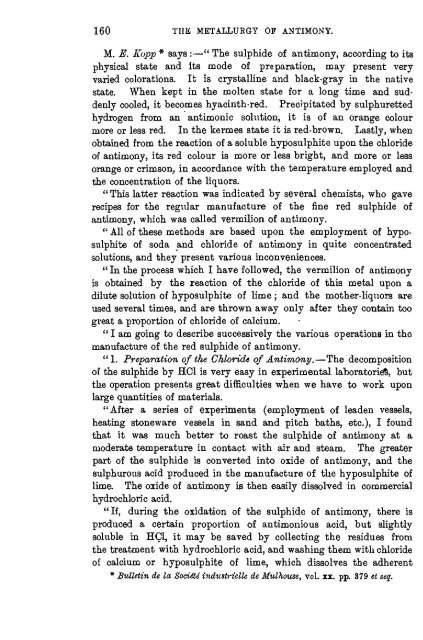antimony - Sciencemadness.org
antimony - Sciencemadness.org
antimony - Sciencemadness.org
Create successful ePaper yourself
Turn your PDF publications into a flip-book with our unique Google optimized e-Paper software.
160 THE METALLURGY OF ANTIMONY.<br />
M. E. Kopp * says :—" The sulphide of <strong>antimony</strong>, according to its<br />
physical state and its mode of preparation, may present very<br />
varied colorations. It is crystalline and black-gray in the native<br />
state. When kept in the molten state for a long time and suddenly<br />
cooled, it becomes hyacinth-red. Precipitated by sulphuretted<br />
hydrogen from an antimonic solution, it is of an orange colour<br />
more or less red. In the kermes state it is red-brown. Lastly, when<br />
obtained from the reaction of a soluble hyposulphite upon the chloride<br />
of <strong>antimony</strong>, its red colour is more or less bright, and more or less<br />
orange or crimson, in accordance with the temperature employed and<br />
the concentration of the liquors.<br />
" This latter reaction was indicated by several chemists, who gave<br />
recipes for the regular manufacture of the fine red sulphide of<br />
<strong>antimony</strong>, which was called vermilion of <strong>antimony</strong>.<br />
" All of these methods are based upon the employment of hyposulphite<br />
of soda and chloride of <strong>antimony</strong> in quite concentrated<br />
solutions, and they present various inconveniences.<br />
" In the process which I have followed, the vermilion of <strong>antimony</strong><br />
is obtained by the reaction of the chloride of this metal upon a<br />
dilute solution of hyposulphite of lime; and the mother-liquors are<br />
used several times, and are thrown away only after they contain too<br />
great a proportion of chloride of calcium.<br />
" I am going to describe successively the various operations in the<br />
manufacture of the red sulphide of <strong>antimony</strong>.<br />
"1. Preparation of the Chloride of Antimony.—The decomposition<br />
of the sulphide by HC1 is very easy in experimental laboratories, but<br />
the operation presents great difficulties when we have to work upon<br />
large quantities of materials.<br />
"After a series of experiments (employment of leaden vessels,<br />
heating stoneware vessels in sand and pitch baths, etc.), I found<br />
that it was much better to roast the sulphide of <strong>antimony</strong> at a<br />
moderate temperature in contact with air and steam. The greater<br />
part of the sulphide is converted into oxide of <strong>antimony</strong>, and the<br />
sulphurous acid produced in the manufacture of the hyposulphite of<br />
lime. The oxide of <strong>antimony</strong> is then easily dissolved in commercial<br />
hydrochloric acid.<br />
"If, during the oxidation of the sulphide of <strong>antimony</strong>, there is<br />
produced a certain proportion of antimonious acid, but slightly<br />
soluble in HC1, it may be saved by collecting the residues from<br />
the treatment with hydrochloric acid, and washing them with chloride<br />
of calcium or hyposulphite of lime, which dissolves the adherent<br />
* Bulletin de la Soci4t4 industricllc de Mulkouse, vol. xx. pp. 379 et se
















